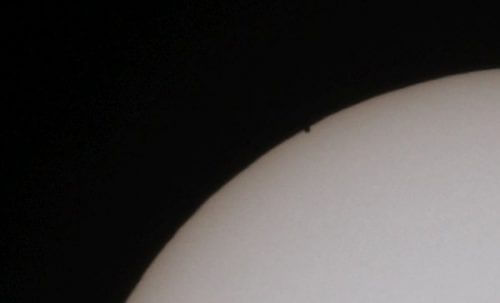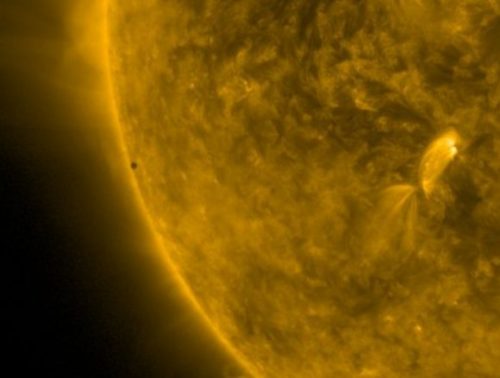It's not every day you see a planet pass by the sun. Yesterday, amateur astronomers all over the world had the opportunity to watch just that, when the tiny planet Mercury crosses in front of the Sun's disk as seen from Earth. This was the first transit of Mercury in front of the Sun since November 8, 2006. The next transit will occur on November 11, 2019.

It's not every day you see a planet pass by the sun. Yesterday, amateur astronomers all over the world had the opportunity to watch just that, when the tiny planet Mercury crosses in front of the Sun's disk as seen from Earth. This was the first transit of Mercury in front of the Sun since November 8, 2006. The next transit will occur on November 11, 2019.

contact! The beginning of the transition as seen from Britain. Image credit and copyright: David Blanchflower.
Events open to the public were held to collectively watch the celestial show. Transits of Mercury, the innermost planet in the solar system, are much more frequent than those of Venus, the second and last planet to cross between the Sun and Earth. The second and last transit of Venus in the 21st century took place on June 6, 2012, and the next - only in 2117.
Unlike Venus, which is the size of Earth, delicate optical instruments are required to watch the tiny dot pass by the Sun. Its angular size is 9 seconds of arc and 180 stars of Hema can be placed in the arc formed by the orbit of the star of Hema from in front of the Sun.
The black dot - planet Mercury, together with a group of black spots on the side facing the Earth. Image credit and copyright: @Blobrana
NASA and countless stargazers around the world broadcast the event live.
.

We're expecting images from the Soho spacecraft at the L1 point between the Earth and the Sun, as well as NASA's Solar Dynamics Observatory, Japan's Hinoda, and the European Space Agency's Probe 2, all of which are in Earth orbit.
It's amazing to see how much photography technology has advanced since the previous transit of the planet Hama in 2006. In those days the Coronado hydrogen telescopes were the hottest thing to look at the sun. Today people have projected and shared safe pictures of the sun through social networks.
Transits of the planet Mercury occur about 13 times a century. The first was observed by Pierre Gassandi on November 7, 1631 and although it is more of an experiential event than a scientific one these days, the transits of Mercury and Venus in past centuries were an essential means of measuring the distance between the Earth and the Sun by measuring the sun's parallax, which in turn provided the numerical values of magnitude The solar system in relation to the distance of the earth from the sun. Today we know that the Sun's plexus is tiny - about 8.8 seconds of arc, smaller than the disk of the planet Mercury as seen in the current eclipse.
Finally, the Universe Today website was asked when Venus and Mercury will pass together in front of the Sun. You have to remember that the further you look, the greater the uncertainty. Anyway for those interested, it will happen on September 17, 13,425. If that's too far, perhaps you could hop over to Antarctica to watch the transit of Mercury during a partial solar eclipse - on July 5, 6757.
For the full article in UNIVERSETODAY - including additional photos
